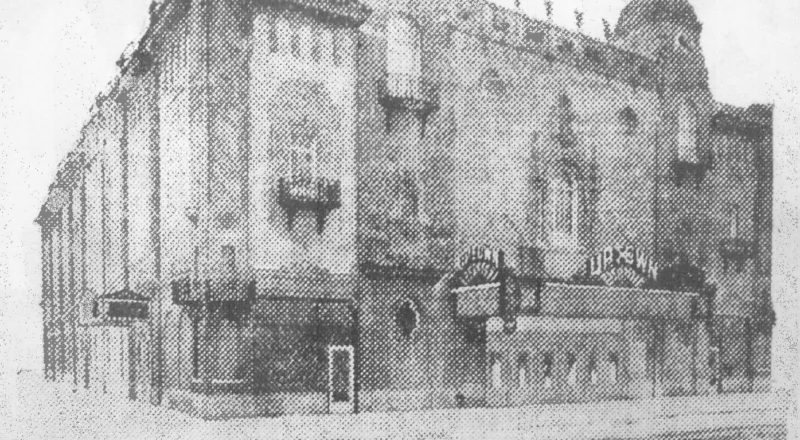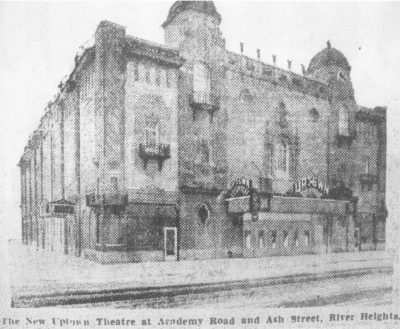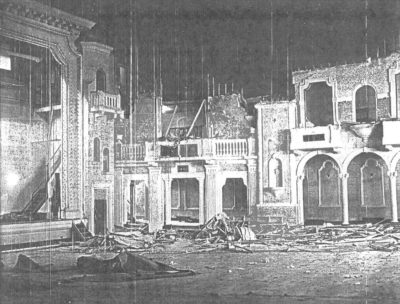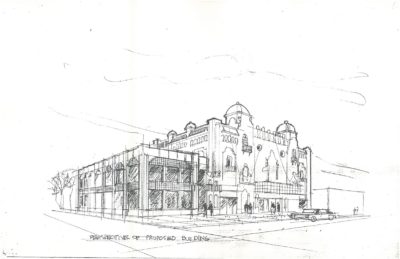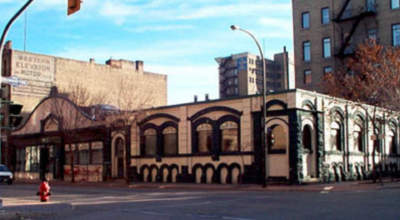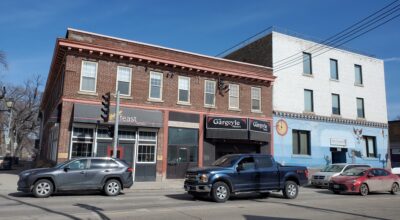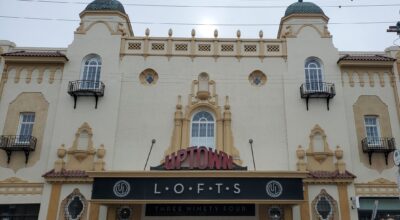
/ Blog
May 16, 2018
A Remnant of Film’s Golden Age: The Uptown Theatre
Many Winnipeggers will remember having birthday parties as a child at Academy Lanes Bowling – making funny nicknames on the machine, bowling the occasional strikes (more rolling into the gutter), and finally upstairs for pizza at dinnertime. Academy Lanes has been a staple of Central Winnipeg for many many years – but the building that houses it has been around for much longer.
The Uptown Theatre was built in 1931 as the latest in a series of theatres designed by Russian-born Winnipeg architect Max Zev Blankstein, and owned by another Russian Winnipegger, Jacob “Jack” Miles. Both these men, along with many other families, had fled Russia to escape religious persecution (both are buried in Shaarey Zedek cemetery, a historic site in its own right). Max Blankstein was among the very first Jewish architects to register and practice in Manitoba.
By all accounts, Uptown Theatre was a sight to see in its heyday of the Golden Age of Film. Mixing Spanish, Islamic, and Art Deco influences, the grand theatre seemed right out of the tales of Scherezade – particularly to Depression-era Winnipeggers, who could probably use a little wonder and escapism. This particular architectural style for movie theatres was called “Atmospheric” for its aim to fully transport patrons from their city to a completely different time and place. Many atmospheric theatres were modelled on particular wondrous places from Europe, Africa, and the Near East. Popular inspirations were Versailles, Egypt, as well as the Moorish palace of the Alhambra in Granada, Spain.
Other beautiful examples of early-20th century atmospheric movie theatres modelled in the same style as the Uptown Theatre include the Paradise Theatre (built 1929), now the Paradise Centre for the Arts in Faribault, Minnesota as well as the much more elaborate Tampa Theatre (1926), which was named one of America’s 21 Wonders by Life Magazine in 2007. It was as though the theatres themselves reflected the far-away and exciting locales that were present in the films that audiences would go to see. These Golden Age films included the horrifying Frankenstein (1931), the exciting Mata Hari (1931), and the thrilling and fantastical Tarzan the Ape Man (1932).
Audiences entered the theatre to find a dramatic ceiling painted to look like a starry night, with a projector displaying scudding clouds and the real-time motion of the moon across the night sky. Once they collected themselves enough to look around, they saw graceful arches, winding columns, and a grand screen framed by rich burnt orange and blue trimmed curtains. Feeling as though they were actually outside, patrons experienced Winnipeg’s then-only “refrigerated” theatre in comfort and wonder as they watched early showings of new Hollywood movies on “Sneak Peek Thursdays”. Of course, you’d have to shell out 35 cents for a ticket, or the pricey 50 cents if you wanted a prime sofa seat in the lounge area – but only 15 cents for children!
As technology became more and more complex and portable, Winnipeggers began to go to the “picture shows” less and less as they became accustomed to watching shows in their homes – with the help of the modern television set. The once-grand Uptown Theatre fell into disrepair, and the owner made the decision to gut the interior and turn this theatre into a bowling alley in the 1960s. Academy Uptown Lanes was very popular with youth, and thrived for a number of years. In fact, this particular bowling alley is credited with bringing “glow bowling” into Winnipeg and reviving the bowling scene.
Sometime in the mid-1980s, the building’s owner, David Miles, applied to the City of Winnipeg for a demolition permit, and that’s where the story really begins. When two local River Heights residents heard that the demolition permit had been approved by the City, they attended a City Hall meeting where Heritage Winnipeg attended and encouraged them to talk to others in the neighbourhood and try and save the theatre with Heritage Winnipeg’s support. Having collected over 270 signatures from surrounding homeowners in the area over a few days, Elizabeth Fleming and Patricia Gove took their petition to the City, to the Historical Buildings Committee, to whoever would listen to them and could do something about the demolition of the Uptown Theatre. In other words: We felt cheated and short-changed, and decided we were not going to let them get away with it.
Several members of the Winnipeg South Centre community felt the same about the Uptown Theatre as Elizabeth and Patricia did. They had a series of meetings with the City, the owner, the community committees, and Heritage Winnipeg, and discussed all aspects of the historic building. Indeed, a then-recent assessment (October 1985) from the City of Winnipeg Historic Buildings Committee had recommended that it be designated as a Grade III historic building, and a Summary of Historic Research had ended with the evaluation that the Uptown Theatre “remains definitive to the Academy Road streetscape and a landmark in the neighbourhood.”
The ultimate result was that the owner was concerned about the economic viability of the building (and the estimates for renovations to the historic theatre were well around $1,000,000), so a compromise was made to allow an addition on the side of the building, and in return have the building officially designated as a Grade III historic building and make the owner responsible for repairing and maintaining the beautiful north facade of the building. In 1986, the Uptown Theatre was officially designated as a Grade III historic building, which covers the facade and exterior of the building. This success was due in no small part to the action of dedicated neighbourhood citizens and the heritage community, who wanted to see the building saved.
Another, less obvious outcome from this case was the changes in municipal bylaws for economic viability assessment and the funding available for owners to encourage preservation of historic buildings. Previously, the City of Winnipeg made a judgement of economic viability based on information from the owner of a building. However, during the debate about the fate of the Uptown Theatre, one councillor writes:
…we have not given the Committee the resources with which to make any independent assessment of the arguments put to it…indeed the fate of the building in question could well turn precisely on whether or not some alternative to the owner’s analysis and proposal proved to be possible
March 13, 1985
Later, the city would be given the power to make its own independent assessment of the economic viability of a building. This change helped open up more creative solutions to preserving heritage buildings while simultaneously making provincial grants available for owners of heritage buildings, making renovations more viable, in turn extending the future use of buildings. More recently, in April 2018 Academy Lanes closed its doors at 394 Academy Rd., citing increased rental costs and an inability to come to a new agreement with the building’s owner. While the new tenant of the historic theatre is uncertain, we know that due to the part efforts of dedicated citizens and the heritage community, the beautiful facade of Uptown Theatre is part of the city’s protected built heritage and will continue to be part of the River Heights landscape.
THANK YOU TO THE SPONSOR OF THIS BLOG POST:

Written by Heritage Winnipeg.
SOURCES:
About Us | Paradise Center for the Arts
History | Lido Theatre, The Pas
Silver Screens on the Prairie: An Illustrated History of Motion Picture Theatres in Manitoba | Russ Gourluck - 2012
Theatrical debut | Christian Cassidy - July 2, 2017 - Winnipeg Free Press
Uptown Theatre | Canada's Historic Places - Parks Canada





